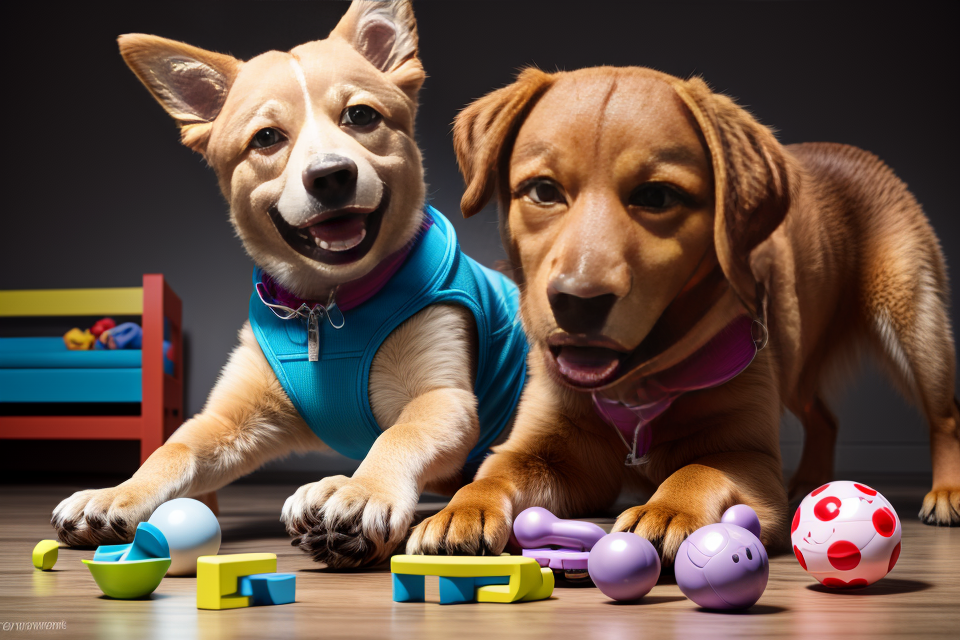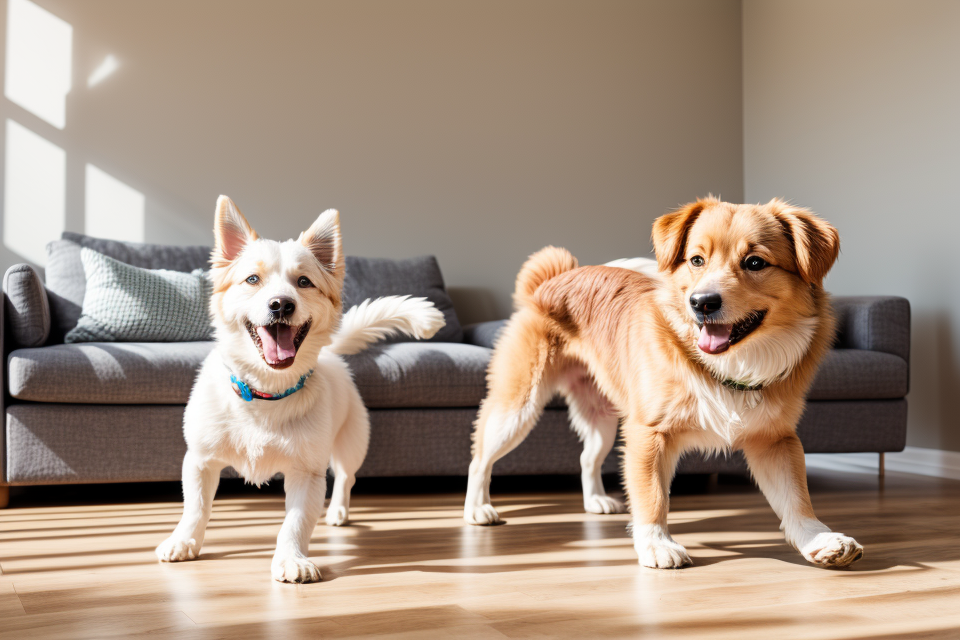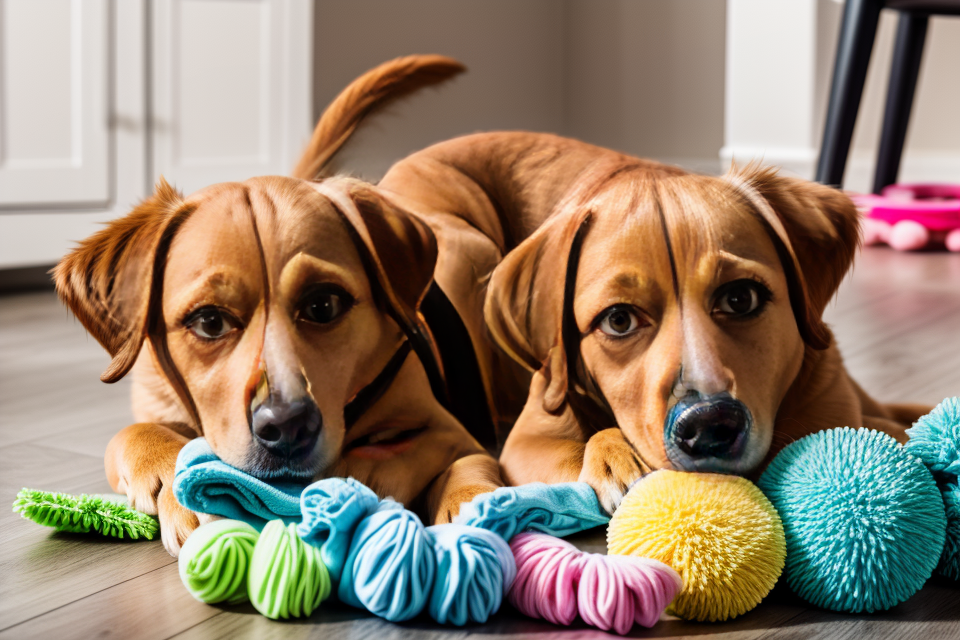Is your furry friend feeling a little down in the dumps lately? Does he seem to be losing interest in his favorite toys and games? If so, it’s possible that your dog is experiencing separation anxiety. This can be a difficult situation for both you and your pet, but there are ways to help alleviate the boredom and keep your dog entertained while you’re away. In this article, we’ll explore the best toys for dogs with separation anxiety, and provide some tips on how to keep your furry friend happy and engaged even when you’re not around. So, let’s get started!
Types of Toys for Bored Dogs
Interactive Toys
- Puzzle toys
- These toys challenge dogs to figure out how to get a treat or toy out of a puzzle. Examples include toys that require dogs to push or pull a lever, turn a knob, or manipulate a hidden compartment to get a reward.
- Puzzle toys are great for mental stimulation and can help prevent boredom and destructive behavior.
- Hide and seek toys
- These toys challenge dogs to find a hidden treat or toy. Examples include toys that have a small opening for dogs to push a toy out of, or toys that have small openings that contain treats.
- Hide and seek toys are great for mental stimulation and can help prevent boredom and destructive behavior.
- Food-dispensing toys
- These toys dispense food or treats when dogs interact with them in a certain way. Examples include toys that dispense food when dogs push a button or spin a wheel.
- Food-dispensing toys are great for mental stimulation and can help prevent boredom and destructive behavior.
Durable Toys
When it comes to keeping dogs entertained and engaged, durable toys are an excellent option. These toys are designed to withstand the rough play and tough chewing of even the most energetic of dogs. Here are some examples of durable toys that can help keep your dog busy and happy:
Rope Toys
Rope toys are a popular choice for dogs because they are soft on their teeth and jaws, and they can be easily picked up and carried around. They also come in a variety of shapes and sizes, making them suitable for dogs of all ages and sizes. Rope toys can be filled with treats or stuffed with a small amount of peanut butter or cheese to make them even more enticing to your dog.
Tug Toys
Tug toys are great for dogs who love to play fetch and tug-of-war. They are usually made of durable materials like nylon or rope, and they come in a variety of sizes and shapes. Some tug toys are designed to be thrown and retrieved, while others are designed to be pulled and tugged. Tug toys can help satisfy your dog’s natural instinct to chase and retrieve, and they can also help improve their agility and coordination.
Fetch Toys
Fetch toys are perfect for dogs who love to play fetch and catch. They come in a variety of shapes and sizes, from small balls to large plush toys. Some fetch toys are designed to be thrown and retrieved, while others are designed to be rolled or kicked. Fetch toys can help improve your dog’s retrieving skills, and they can also provide mental stimulation and exercise.
Overall, durable toys are a great option for dogs with separation anxiety because they can keep your dog engaged and entertained for extended periods of time. They are also versatile and can be used in a variety of settings, from the backyard to the park to the living room.
Sensory Toys
Sensory toys are an excellent option for dogs with separation anxiety as they are designed to stimulate a dog’s senses and keep them engaged while you’re away. Here are some types of sensory toys that can help alleviate boredom and reduce separation anxiety in dogs:
Chew Toys
Chew toys are designed to satisfy a dog’s natural instinct to chew, which can help reduce stress and anxiety. There are many types of chew toys available, including rope toys, rubber toys, and plush toys. When choosing a chew toy, it’s essential to select one that is durable and safe for your dog. Look for toys made from materials like nylon, polyester, or natural rubber, and avoid toys with small parts that could be swallowed.
Rubber Toys
Rubber toys are a popular choice for dogs as they are durable, flexible, and can be filled with treats or peanut butter for added incentive. Some rubber toys even have small ridges or bumps that can massage a dog’s gums as they chew, providing oral stimulation. When selecting a rubber toy, choose one that is large enough for your dog to handle comfortably and avoid toys with small parts that could be swallowed.
Textured Toys
Textured toys are designed to provide sensory stimulation through touch. These toys can be made from a variety of materials, including rope, rubber, or plush fabrics. Some textured toys are designed with ridges, bumps, or knots that can massage a dog’s gums as they chew, providing oral stimulation. Other textured toys are designed with different patterns or textures that can stimulate a dog’s sense of touch. When selecting a textured toy, choose one that is appropriate for your dog’s size and chewing habits.
How to Choose the Right Toys for Your Dog
Consider Your Dog’s Size and Strength
When choosing toys for your dog with separation anxiety, it’s important to consider their size and strength. Dogs with separation anxiety tend to be high-energy and may become destructive if they don’t have appropriate outlets for their energy. To prevent injury, it’s important to choose toys that are appropriate for your dog’s size and strength. Here are some tips to keep in mind:
- Small dogs: For small dogs, choose toys that are soft and flexible, such as plush toys or rope toys. Avoid toys with small parts that could be swallowed or choked on.
- Medium dogs: For medium-sized dogs, choose toys that are sturdy and can withstand play, such as rubber balls or stuffed toys. Avoid toys that are too large for your dog to pick up and carry.
- Large dogs: For large dogs, choose toys that are durable and can stand up to rough play, such as rubber bones or hard plastic toys. Avoid toys that are too small for your dog to pick up and could be swallowed or choked on.
By choosing toys that are appropriate for your dog’s size and strength, you can help prevent injury and provide your dog with appropriate outlets for their energy and playfulness.
Be Mindful of Your Budget
When it comes to choosing the best toys for your dog with separation anxiety, it’s important to consider your budget. You don’t want to spend a lot of money on toys that your dog won’t enjoy or that won’t last long. However, you also don’t want to skimp on quality toys that can provide hours of entertainment and help alleviate your dog’s separation anxiety.
To find the right balance, consider the following factors:
- Durability: Look for toys that are made with high-quality materials that can withstand your dog’s playstyle. Some toys, like rubber balls, are more durable than others, like plush toys.
- Value: Consider the price of the toy in relation to its value. Some toys may be more expensive, but they can last longer and provide more entertainment for your dog.
- Age and size: If you have a small dog or a puppy, you may want to avoid toys that are too large or too complex for them to handle. Similarly, if you have a large dog, you may want to choose toys that are designed for their size and strength.
By considering these factors, you can find the best toys for your dog that fit within your budget.
DIY Toys for Bored Dogs
Ideas for Homemade Toys
Old T-shirts or towels
- Tossing a t-shirt or towel is a simple way to keep your dog entertained.
- This can be especially helpful if you’re short on time and need to quickly distract your dog.
- You can also try stuffing the t-shirt or towel with treats for an extra special treat.
Plastic bottles
- Filling a plastic bottle with treats or small toys is a great way to keep your dog busy.
- The squeaking noise that the bottle makes will also provide additional stimulation.
- Be sure to supervise your dog while they play with the bottle to ensure they don’t break it and choke on the contents.
Cardboard boxes
- Cardboard boxes can provide hours of entertainment for your dog.
- You can cut the box into smaller pieces to make a puzzle for your dog to solve.
- You can also fill the box with treats or toys and hide them for your dog to find.
- Make sure to remove any tape or glue from the box before giving it to your dog.
Tips for Making DIY Toys
When it comes to creating DIY toys for your dog, there are a few tips to keep in mind to ensure that the toys are safe, engaging, and durable.
- Use safe materials: When selecting materials for your DIY toys, it’s important to choose items that are non-toxic and safe for your dog to chew on and play with. Common materials for DIY toys include rope, fleece, and cardboard. Be sure to avoid any materials that could be harmful to your dog, such as plastic or metal.
- Consider your dog’s interests and preferences: Different dogs have different preferences when it comes to toys. Some dogs love to chew, while others prefer toys that they can play fetch with. Think about your dog’s interests and preferences when choosing materials and designing the toy.
- Make sure the toys are sturdy and durable: DIY toys should be able to withstand plenty of playtime and rough handling. Consider using strong materials, such as rope or leather, and reinforcing the toy with duct tape or heavy-duty stitching. This will help ensure that the toy can stand up to your dog’s playful antics.
By following these tips, you can create DIY toys that are both fun and safe for your dog to play with, even if they suffer from separation anxiety.
How to Rotate Toys to Keep Your Dog Engaged
Tips for Rotating Toys
Set a Schedule for Rotating Toys
- One way to keep your dog engaged is to set a schedule for rotating their toys. This can help prevent boredom and keep your dog interested in their playthings.
- A good rule of thumb is to rotate toys every few days to a week, depending on how often your dog plays with them.
- You can also rotate toys based on your dog’s preferences. If they seem to enjoy one toy more than others, rotate it less frequently to keep it interesting.
Store Unused Toys in a Safe Place
- Another tip for rotating toys is to store unused toys in a safe place. This can help prevent your dog from becoming bored with the same toys all the time.
- Consider storing unused toys in a separate room or in a storage bin with a lid. This will keep them out of reach of your dog and prevent them from becoming damaged or destroyed.
Consider Using a Toy Dispenser to Keep Toys Fresh and Interesting
- A toy dispenser is a great way to keep toys fresh and interesting for your dog. These dispensers can be filled with a variety of toys and treats, and your dog can access them by pulling on a rope or lever.
- Toy dispensers come in a variety of sizes and styles, so you can choose one that works best for your dog’s needs and preferences.
- Some toy dispensers are designed specifically for dogs with separation anxiety, as they can provide mental stimulation and prevent boredom while you’re away.
Other Ways to Keep Bored Dogs Engaged
Providing Mental Stimulation
Providing mental stimulation is essential for dogs with separation anxiety, as it helps keep their minds engaged and prevent them from becoming bored and anxious. Here are some ways to provide mental stimulation for your dog:
Teach your dog new tricks and commands
Teaching your dog new tricks and commands is an excellent way to provide mental stimulation. It not only keeps their minds engaged but also strengthens the bond between you and your dog. Start with simple commands like “sit” and “stay” and gradually increase the difficulty level as your dog becomes more proficient. You can also try teaching your dog tricks like “high five” or “wave.”
Engage in interactive play sessions
Interactive play sessions are another great way to provide mental stimulation for your dog. Playing games like hide and seek or fetch can help keep your dog’s mind engaged and prevent boredom. You can also try new games or toys to keep things interesting.
Try scent work or nose work
Scent work or nose work is a fun and engaging activity for dogs. It involves using your dog’s sense of smell to find hidden objects or complete a task. This type of mental stimulation is great for dogs with separation anxiety because it keeps their minds engaged and focused on something other than their anxiety. You can start by hiding treats or toys and having your dog find them, and gradually increase the difficulty level as your dog becomes more proficient.
Exercise and Physical Activity
- Take your dog for walks or runs: Walking or running with your dog is a great way to provide exercise and mental stimulation. This can also help tire out dogs with separation anxiety, making them more relaxed during times when they are left alone.
- Play fetch or tug in a safe, open space: Fetch and tug games are great for providing physical activity and mental stimulation. These games can be played in a safe, open space such as a park or backyard. It’s important to make sure the toys used in these games are safe and appropriate for your dog.
- Enroll your dog in dog sports or agility classes: Dog sports and agility classes are a great way to provide physical activity and mental stimulation for dogs. These activities can help build confidence and strengthen the bond between a dog and its owner. Some examples of dog sports include obedience, agility, and earthdog trials.
FAQs
1. What types of toys are best for bored dogs?
Dogs that are prone to separation anxiety can benefit from toys that provide mental stimulation and help alleviate boredom. Toys that encourage problem-solving, such as puzzle toys and interactive games, are great options. Toys that provide a sense of security, such as stuffed animals or blankets, can also be helpful. It’s important to rotate toys frequently to keep things interesting and prevent boredom.
2. How often should I replace toys for my bored dog?
It’s a good idea to replace toys frequently, especially if your dog is prone to destroying them. Rotating toys on a regular basis can help keep things interesting and prevent boredom. Depending on the type of toy and how often your dog plays with it, you may need to replace toys every few days to a week.
3. Can I use treats as a reward for my bored dog?
Yes, treats can be a great way to reward your dog for playing with their toys. Using treats as a reward can help reinforce positive behavior and encourage your dog to engage in playtime. It’s important to use high-value treats, such as small pieces of chicken or cheese, to make the reward more enticing.
4. How much time should I spend playing with my bored dog?
The amount of time you should spend playing with your bored dog will depend on their individual needs and personality. Some dogs may be content with short play sessions, while others may require longer sessions. It’s important to monitor your dog’s behavior and adjust the length of playtime accordingly. If your dog is displaying signs of separation anxiety, it may be helpful to increase the amount of time you spend playing with them.
5. Are there any toys that are specifically designed for bored dogs?
Yes, there are many toys specifically designed for dogs that suffer from separation anxiety. Puzzle toys, interactive games, and chew toys are all great options. There are also toys that provide a sense of security, such as stuffed animals or blankets. It’s important to choose toys that are appropriate for your dog’s size and age, and to rotate toys frequently to keep things interesting.



